Christmas lights can be a beautiful sight to behold. Stringing lights around your home can be a real safety hazard if you’re not careful. For outdoors use the lights you need to have lights that are designed to be used outdoors. The lights made for outdoors used can withstand the outdoors conditions – meaning possibly sun, rain, freezing cold, snow, ice and wind. For user safety those lights need to be used correctly.
For electrical safety point of view outdoors is a demanding location. As we all know, water and electricity does not match well, so lights need to be designed to that they keep the mains voltage safely inside the light set. I don’t want to touch the 230V AC mains voltage. This means that the light set needs to be built to have water-tight electrical insulation or it needs to operate at safe low voltage (in which case insulation quality does not matter that much).
For safety point of view I prefer to use outdoors lights that have light string operated at safe low voltage (typically 24V AC that is SELV voltage level). Those lights are powered with safety isolating transformer that outputs that low voltage at needed power needed for lights (transformer can be located inside or outside depending on the transformer). Safety isolation transformer keeps the low voltage operated light set parts safe to touch even if insulation on then fails for any reason. Quite low power transformer also limits the available current/power in case of short circuit happens somewhere on light set, which reduces the fire hazard (in case of short circuit transformer overload protection cuts the limited power quite soon).
Here is typical traditional outdoor light string that operated with outdoor rated 24V AC transformer. The large number of bulbs (each 2.4V) are wired so that there are many light groups, each having then 2.4V bulbs in series with each other (thus works at 24V). This system works well, but the downside is quite high power consumption compared to light output, limited bulb life and lots of debugging work needed to find the bad light bulbs when light bulb groups go dark.
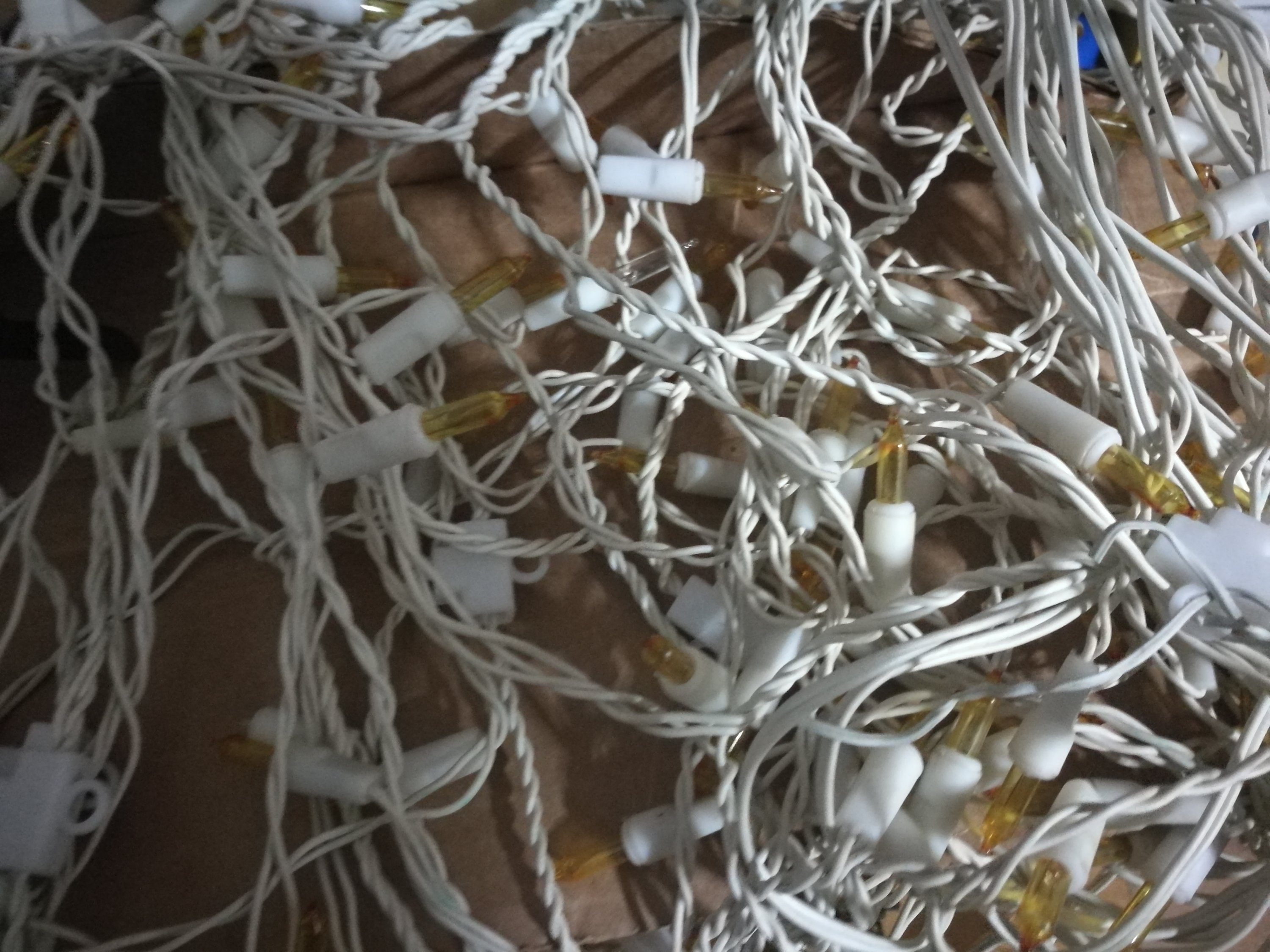
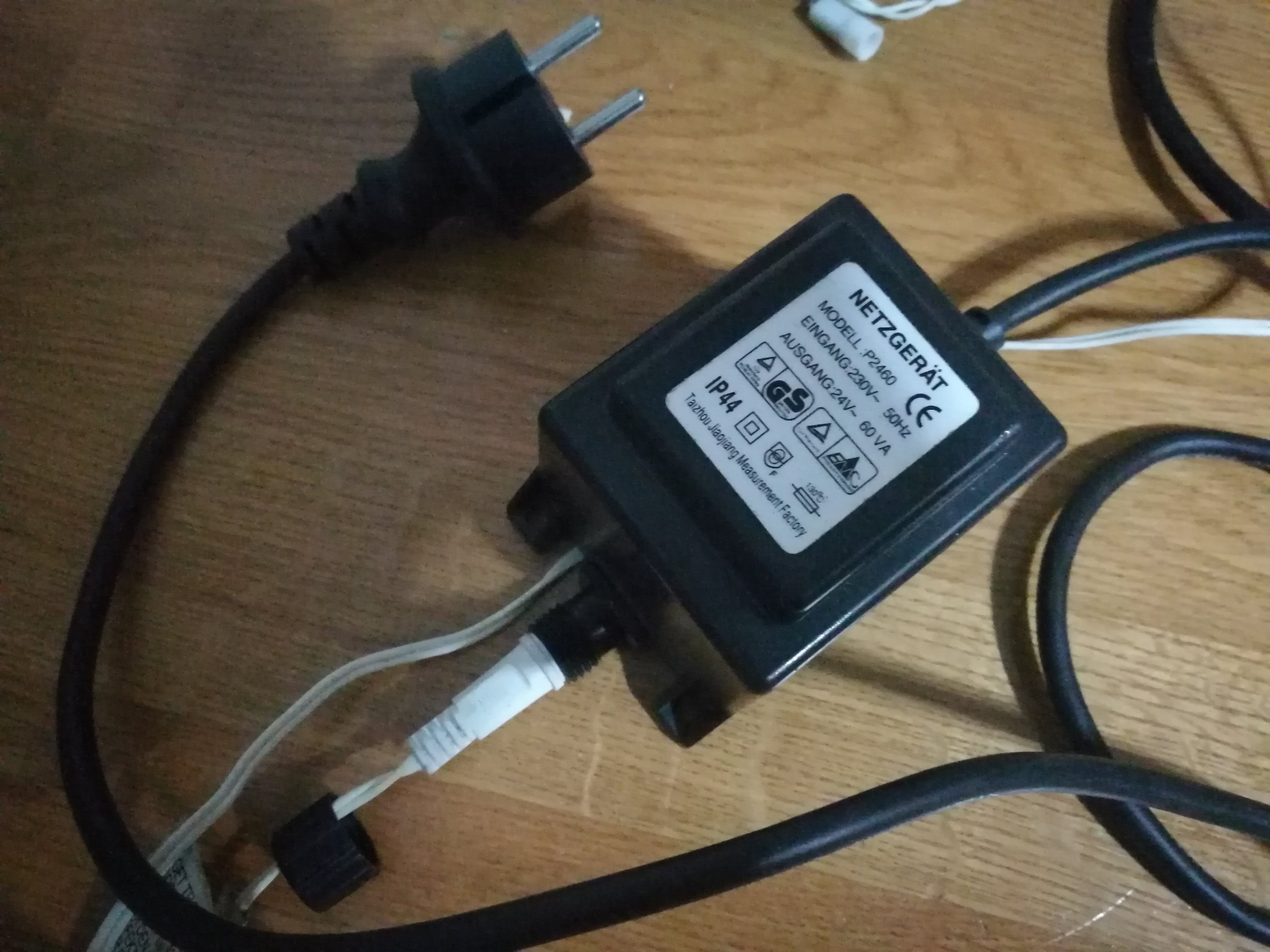
Several years ago LEDs became the mainstream technology. The typical white light LEDs need about 3-3.6V DC voltage to operate. Typically those LEDs are wired in the similar way as the bulbs were, so that the light string can be powered with typically 24V voltage. In this case the power needs to be DC.
In this example older LED light string, there is traditional transformer that gives out 24V AC and the light string has a rectifier that converts it to DC (small white box on wire). This particular LED set seems to be flicker somewhat (can be seen then moving the head), because the DC power fed to the LEDs is not constant, it changes from zero to peak voltage (around 32V) 100 times every second. Some LED light sets have added filtering capacitor after the rectifier to reduce or get rid of flickering.
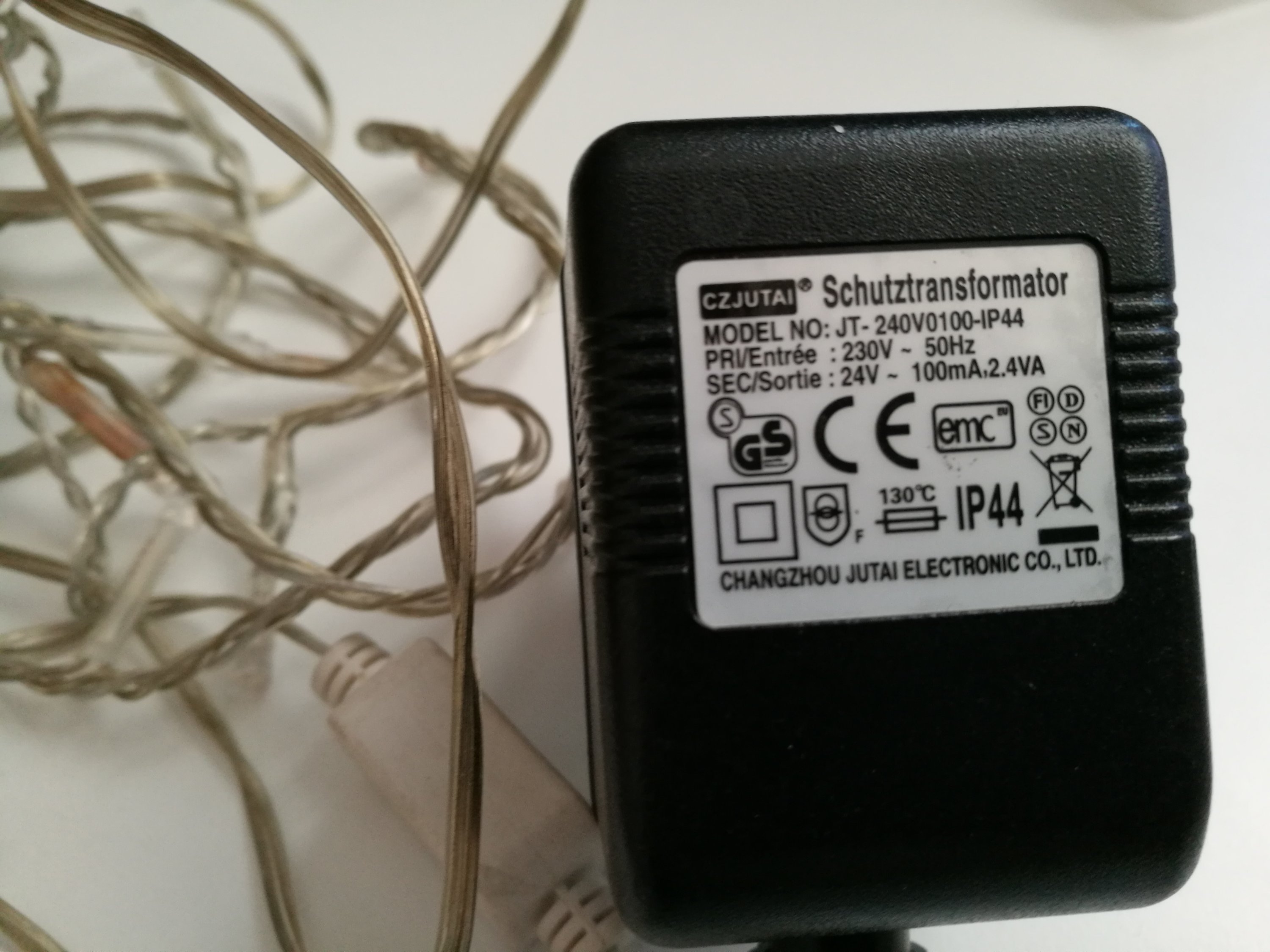
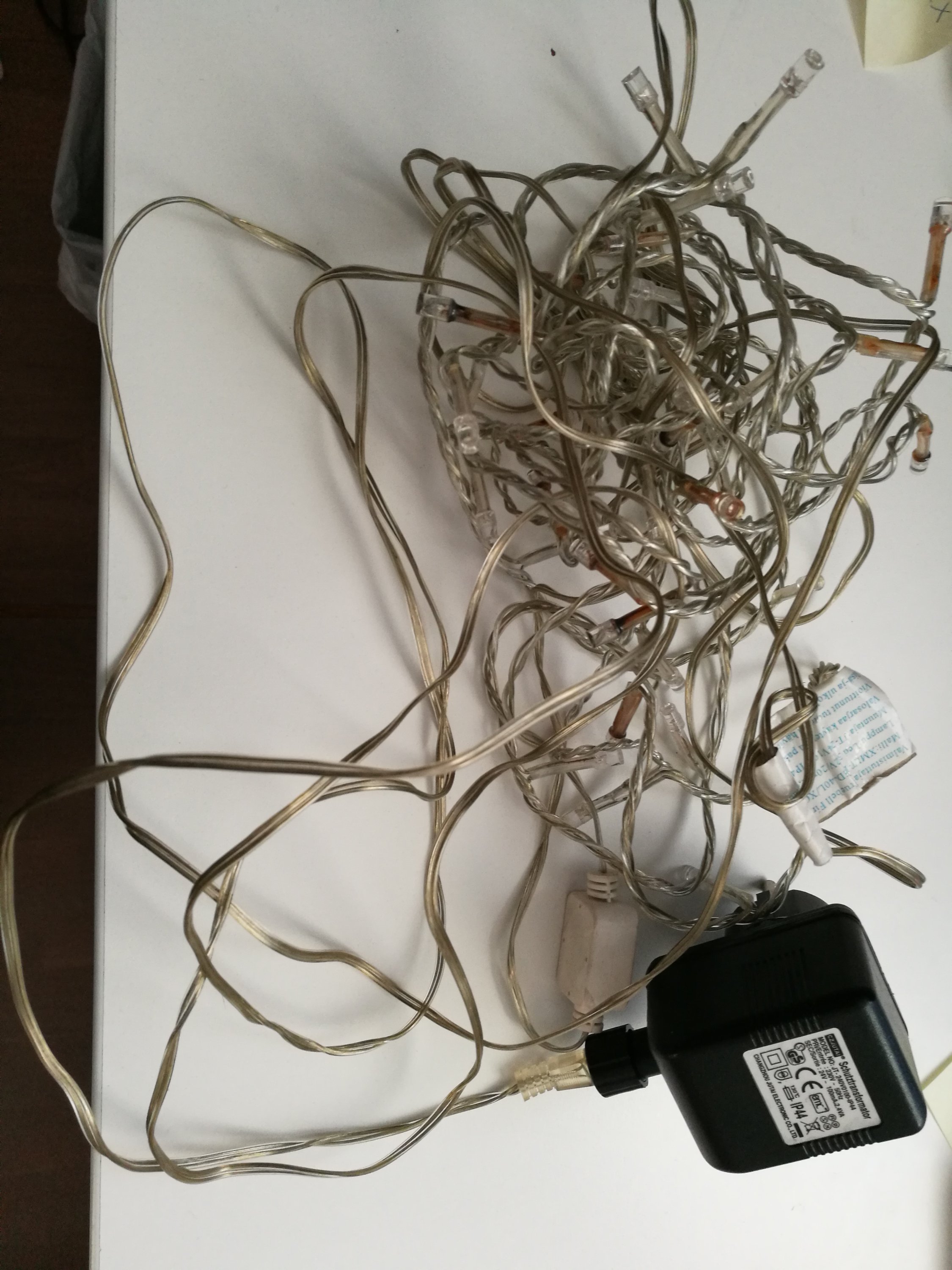
LEDs are marketed to have very long life-span when they are correctly used. In theory they should work for very long time and there is no need to replace LEDs or do fault-finding.
But LED light sets can fail much sooner than LEDs itself (and sometimes even LEDs can fail). The problems I have had with this is that some water can get inside the insulation behind LEDs (plastic heat shrinking tube) so the some electro-chemistry reactions can happen turning the back of LED brown or black. I also encountered one bad soldering joint that failed and needed to be fixed.
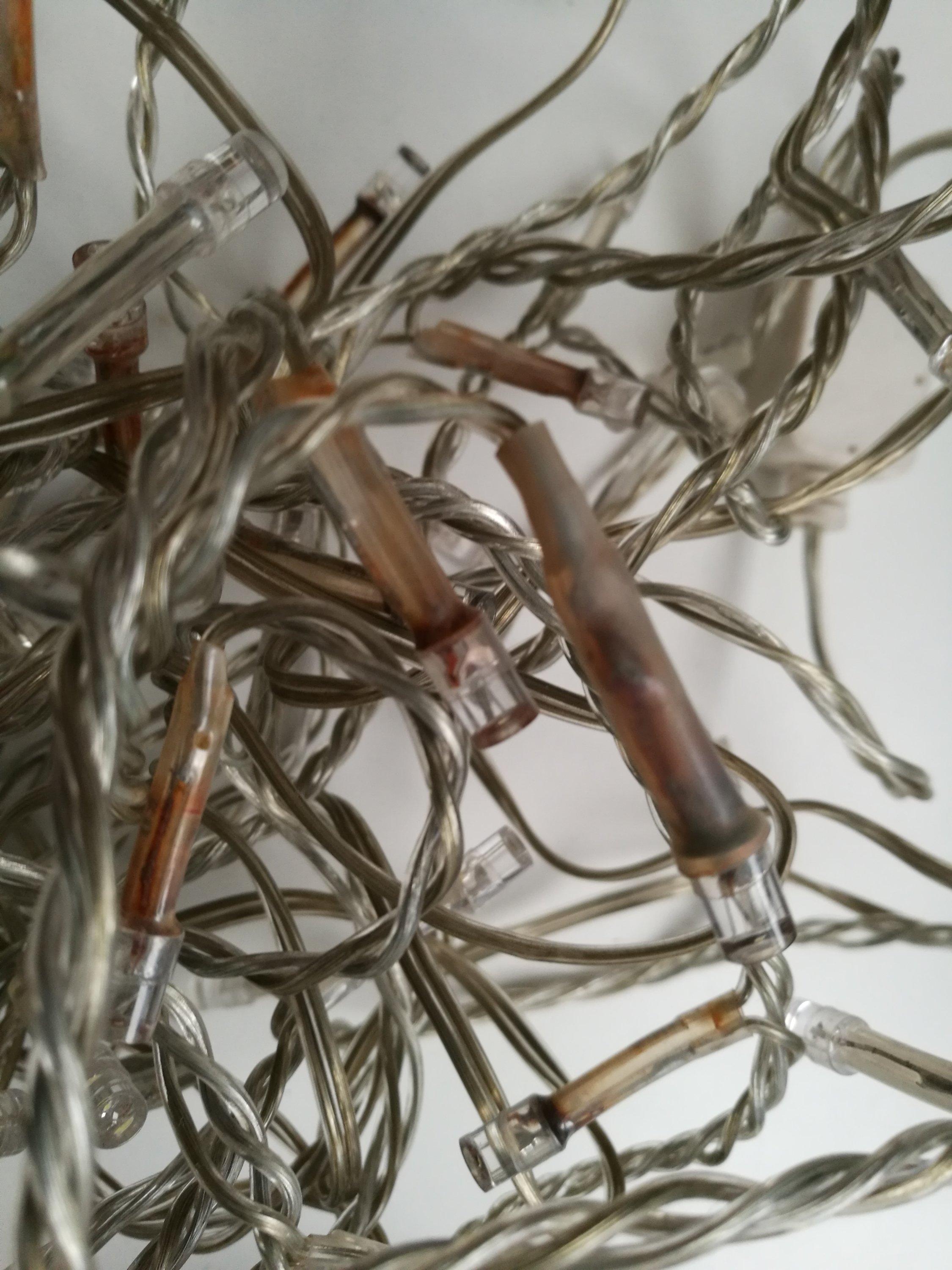
Next version of LED outdoors lights seem to be such that the traditional transformer + rectifier is replaced with AC/DC power supply that supplies safe isolated from mains DC voltage (SELV supply). In the following light the switch mode power supply outputs 31V DC to the LED string. That voltage seems to pretty commonly used (maybe because it is near to rectified 24V AC peak voltage??).
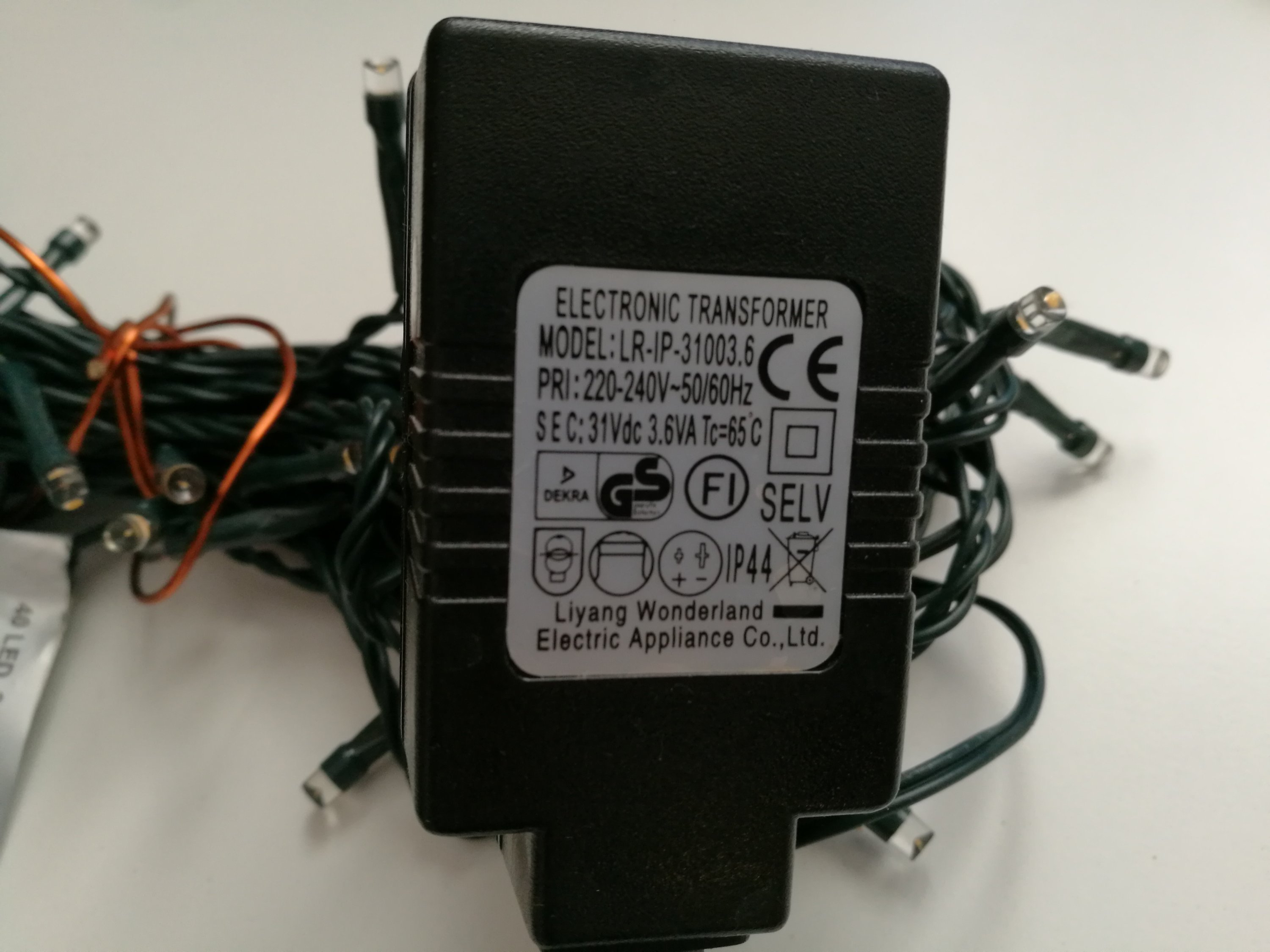
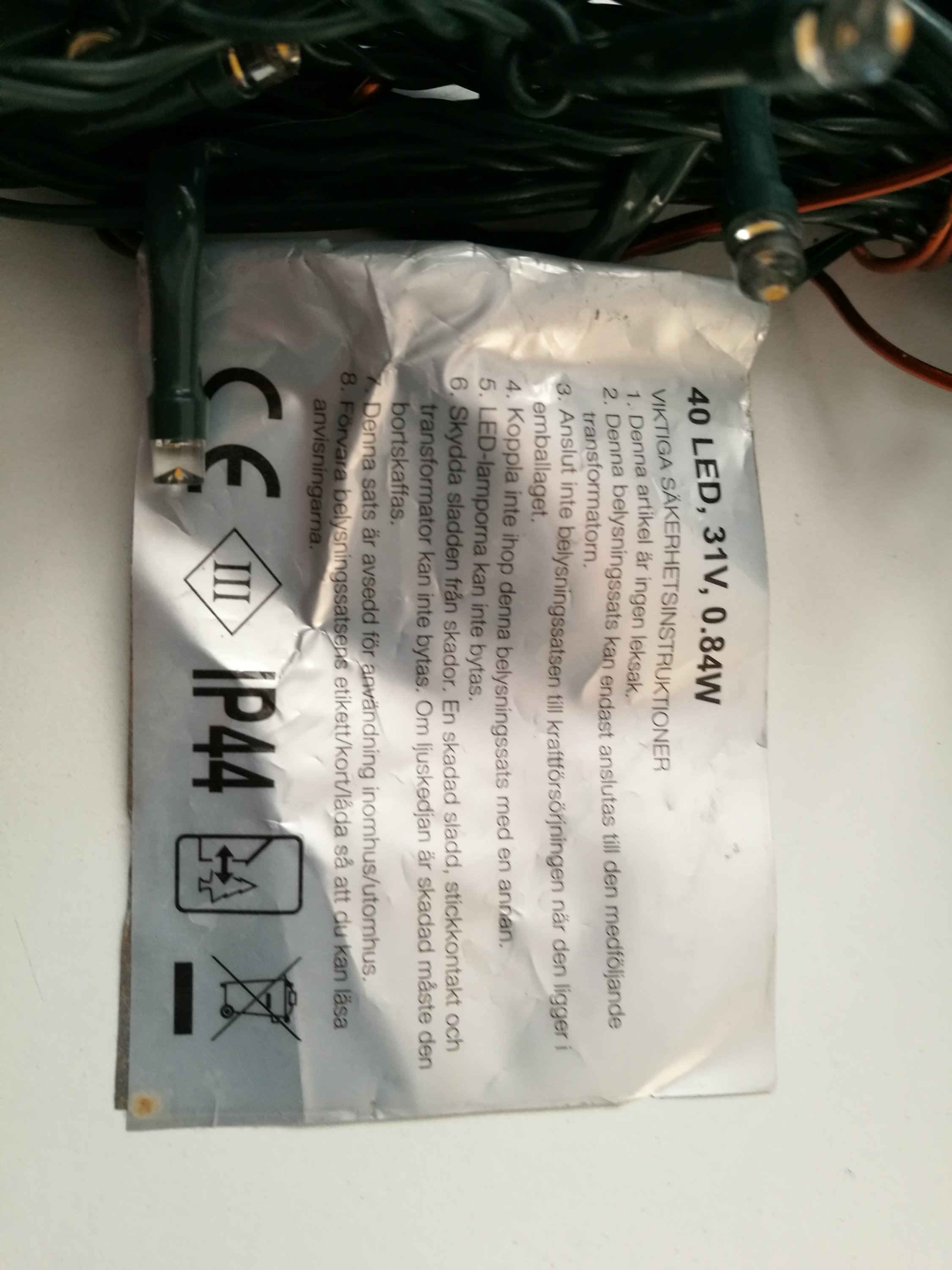
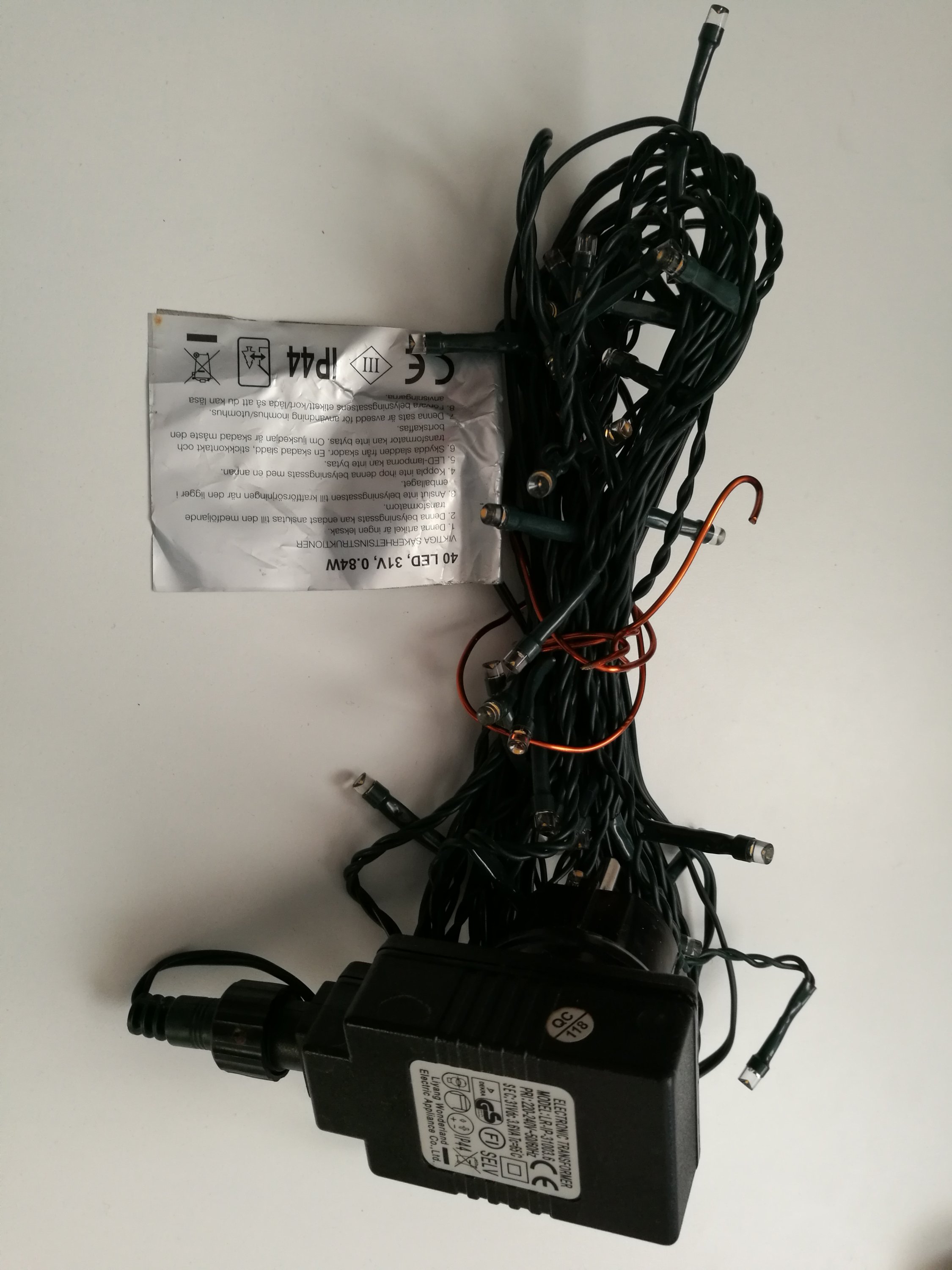
Here is another LED set with DC outputting mains switch mode power supply.
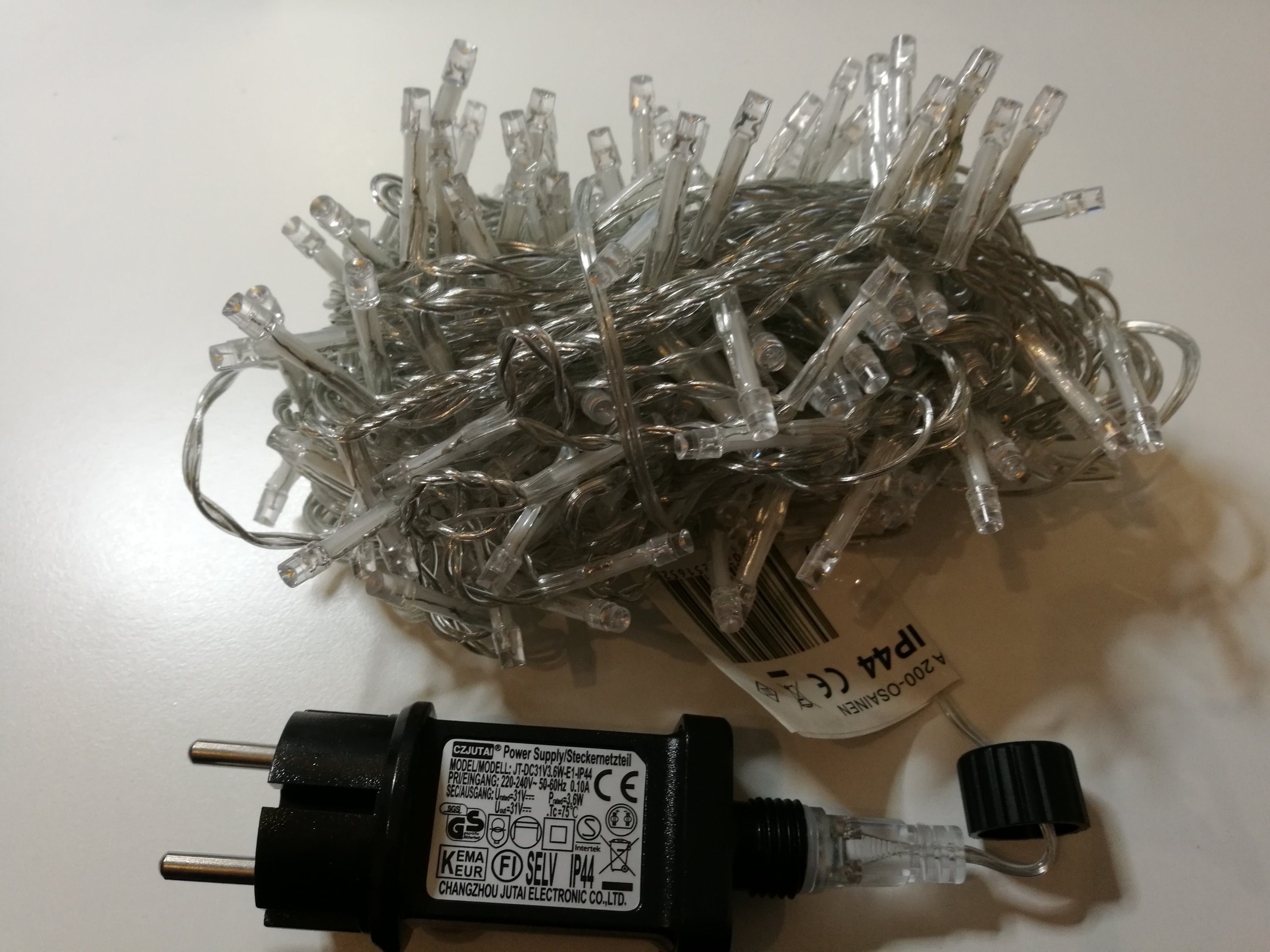
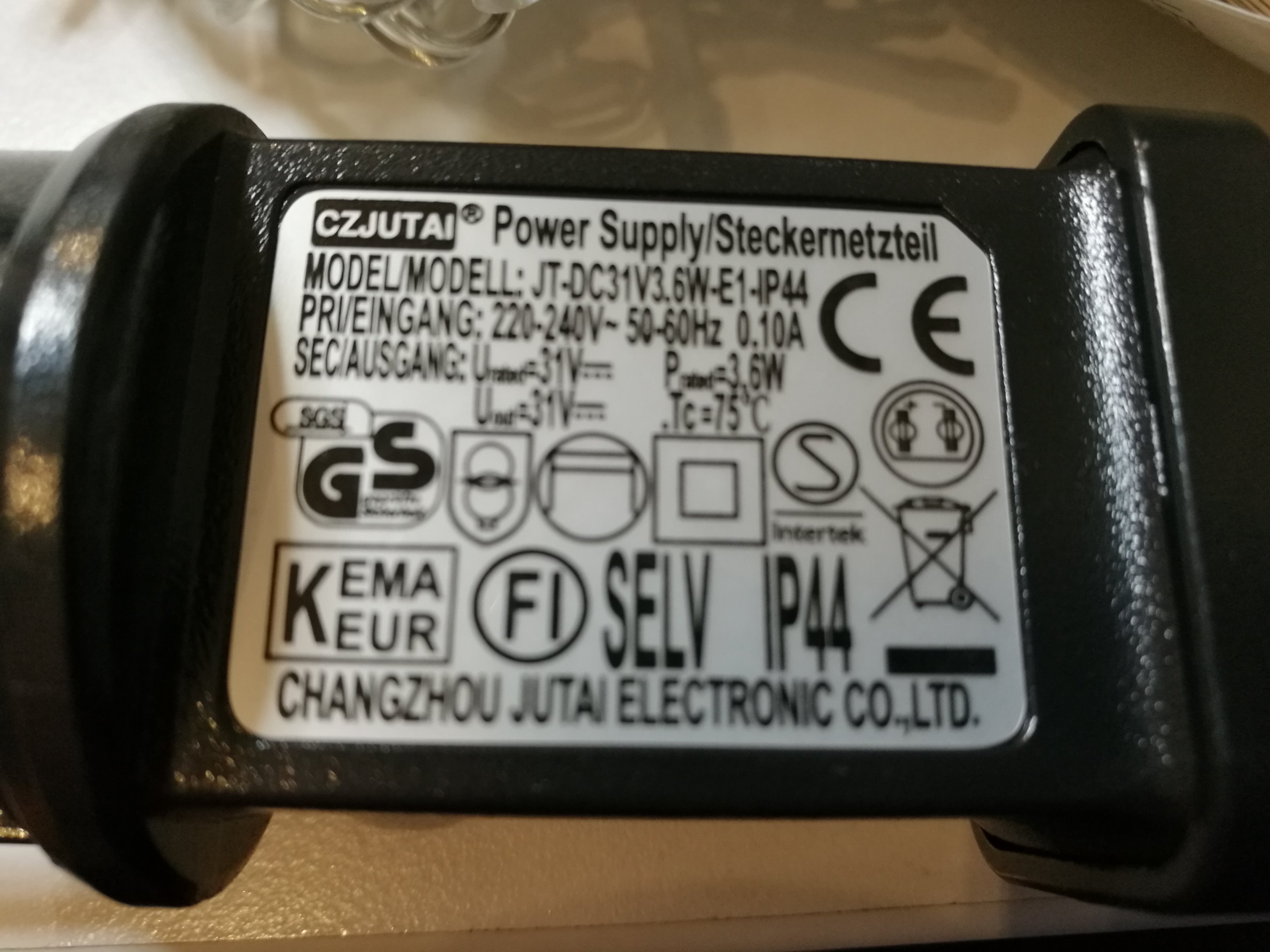
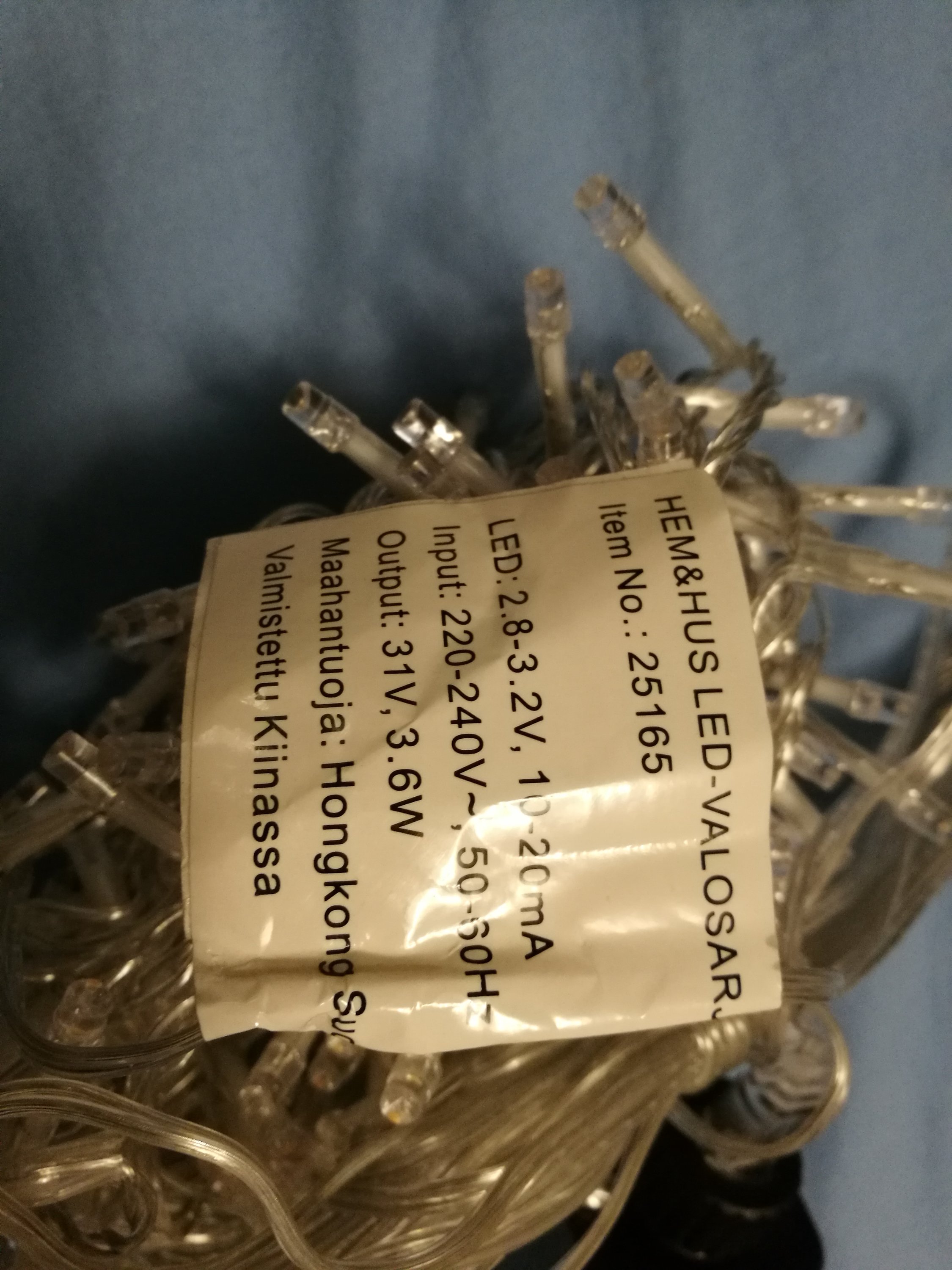
44 Comments
Tomi Engdahl says:
Here is one video on one idea to convert incandescent bulb light string to LED light string.
This conversion looks to suit only to person who knows electrical safety issues and the ends result looks to be suitable for indoors use only (there is non-isolating mains power supply used in this):
Scary work incidents and other answers (with more LEDs.)
https://www.youtube.com/watch?v=ewO-r8_d3uw
Another light set repair/modification video:
LED Christmas Light String Repair!!
https://www.youtube.com/watch?v=X5pHACdLIa0
A simple how-to FIX LED Christmas light strings! A lot of tips and tricks!
Tomi Engdahl says:
Check also related older posting
http://www.epanorama.net/newepa/2013/12/10/christmas-lights-ideas/comment-page-1/#comment-1613470
Tomi Engdahl says:
Lindsay Lights – Wizards in Winter
https://m.youtube.com/watch?feature=youtu.be&v=incq-_C6Kb8
Quite incredible christmas light show example
Tomi Engdahl says:
Flat, mains voltage LED tape.
https://www.youtube.com/watch?v=DXyOUch5taE
I bought some of this mains voltage (240v) LED tape to take a look at. It’s very similar to the mains voltage LED tube-light used in Christmas lighting in that it uses a common rectifier to convert the mains to unsmoothed DC which is connected to two bus wires that run the length of the tube/strip.
Sections of LEDs and resistors wired in series are then tapped off that bus so the tube/strip lights along its full length, but can usually be cut every metre and capped.
In this case each metre has 60 LEDs in series with 22 330 ohm resistors spaced amongst the LEDs to limit the current.
Power dissipation is roughly 5W per metre and the current is about 22mA per metre section.
I thought the rectifier box was moulded onto the cable, but it’s not. It’s just clipped together and while that’s a downside for outdoor use, the chunky rectifier and fuse inside was a pleasant surprise.
The lack of smoothing means there is a slight flicker that may be noticeable in peripheral vision and certainly cause the iPad’s camera issues at the end of the video.
Tomi Engdahl says:
LED tape voltage drop on long runs.
https://www.youtube.com/watch?v=K1j6T-S8yPk
While testing some newly acquired warm white 12V LED tape (5050 and 3528) I noticed that the current for the whole 5m length did not tally with the expected current based on the type of LED and value of the series resistor.
This appears to be down to a modest voltage drop along the run that results in the LEDs at the far end getting a lot less current than the ones at the power supply connection point.
Tomi Engdahl says:
HOW TO FIX LED CHRISTMAS LIGHTS
https://www.youtube.com/watch?v=Mo8Pj62DffA
Easy ways how to fix LED Christmas lights using meter, LED and light keeper pro repair kit tool $16
“how to fix led lights” “how to fix christmas lights”
you have to be very careful replacing LED lights. I would not recommend doing what you showed for risk of burning out every LED in the string. Strings of LED lights are very precisely designed based on the amount of LEDs and the colour.
First of all people need to understand that the forward voltage of LEDs is different for the different colours. Blue and white are the highest where-as red and orange are the lowest. Changing one colour for another, especially when you replace a blue LED with a red one increases the current throughout the entire string.
I would suggest replacing the LED with exactly the same part, unless you can do the electronic calculations.
My local park even agreed with being by the water the LED lights rust in the sockets and failed to work but the incandescent lights always last longer the question you said sand paper what if the rust is inside the light socket
Tomi Engdahl says:
How Christmas Lights work (why when one bulb burns out they all go out, and about new lights)
https://www.youtube.com/watch?v=0MOpfT0f7bQ
Video on how Christmas lights work and why when one bulb burns out they all go out, and about the new lights, that when they burn out, the rest of the strand still stays on.
Tomi Engdahl says:
Light Keeper Pro Audible Voltage Detector Mobile
https://www.youtube.com/watch?v=H65hf7pTjbM
Tomi Engdahl says:
USB powered string of LEDs with clever current sharing trick.
https://www.youtube.com/watch?v=SC9P-fcBqDE
long parallel arrays of LEDs suitable for hacking into outdoor solar lights. I was expecting it to be just a USB plug, resistor and the parallel string of lights, but it turned out quite intriguing.
Firstly, the current was higher than expected at 800mA (8mA per LED) and there’s no resistor!
The combined resistance of the feed and return wire to the far end acts as the resistance, and this arrangement results in even brightness along the full string instead of being brightest at one end and tapering off along the string due to the increasing resistance and voltage drop.
Tomi Engdahl says:
LED Experiments: Making Holiday Lights Less Garish
https://www.youtube.com/watch?v=PBFPJ3_6ZWs
Tomi Engdahl says:
Teardown of an LED window sign.
https://www.youtube.com/watch?v=K46JYuoDwJg
I saw this “OPEN” sign in an asian outlet and couldn’t resist buying one to take to bits.
Notable badness is the mini UK square pin plug that has a sleeved earth pin and no fuse. The capacitor in the capacitive dropper is a 1uF 400V one.
Comments:
This sort of construction requires very few tools and no machine processes. So I can imagine these being hand made by homeworkers in their own homes for very little reward.
It looks like a school GCSE Technology project inside! Then again, it probably was built by a child…
It certainly does look like something I’d have made when I was a kid. But on the other hand, it’s a very cheap way to make large custom signs.
The wiring of those LEDs looks quite nice in my opinion :).
I must condemn the use of an illegal mains plug though.
Tomi Engdahl says:
Everything you didn’t need to know about tungsten Christmas lights.
https://www.youtube.com/watch?v=Vt9wG8um7Rs
So it’s just a string of filament lamps in series is it? Well there’s a bit more to it than that. This video covers the science behind the series strings, fuse lamp, dead-lamp bypass feature and why your lights sometimes seem to pulse really brightly when first powered up.
Tomi Engdahl says:
How to fix LED Christmas lights
https://www.youtube.com/watch?v=OSOxeP-GF4Q
“How to Fix Christmas Lights” video. This time I discuss different kinds of LED lights and how to fix them. It’s very important to understand how something works before working on a solution to the problem.
https://www.ledkeeper.com/home/
How LED Keeper Works
The LED Keeper uses insulation piercing to connect to the copper within the light set wires and illuminate functioning sections by creating mini-circuits. Success will be achieved through the process of elimination.
Tomi Engdahl says:
A look at the inside of LED based neon tube effect.
https://www.youtube.com/watch?v=AZF07D_T2Ug
A look at the construction of an LED based alternative to neon tubing that uses an array of LEDs and heavy diffusion to create a very linear line of light.
Tomi Engdahl says:
Improving a small colour changing fibre-optic decorative lamp.
https://www.youtube.com/watch?v=NmUe1v6ahTY
Tomi Engdahl says:
Teenager automates his family’s holiday lights with an Arduino Mega
https://blog.arduino.cc/2018/12/05/teenager-automates-his-familys-holiday-lights-with-an-arduino-mega/
14-year-old Josiah Davenport decided to animate 3,500 Christmas lights on his family’s home with the help of an Arduino Mega. The lighting pattern is synchronized with the Trans-Siberian Orchestra’s “Wizards in Winter,” which passersby can listen to by tuning in to 89.5 FM on their car radios.
This ambitious installation was started back in July, and took around 100 hours of research, programming, and assembly.
Tomi Engdahl says:
Converting garden lighting to SELV
https://www.youtube.com/watch?v=Tu5l5-BMIA0
Who wants 230V zapping around their garden when it can be converted to a safer 12V using SELV and a presentation converter?
Tomi Engdahl says:
It’s (another) Arduino Christmas.
https://andydoz.blogspot.com/2018/12/its-another-arduino-christmas.html?m=1
Here’s a super simple persistance-of-vision display.
Drive the neighbours mad with 8 static leds, that when they move their head, or drive past, delivers a festive message!
Tomi Engdahl says:
Cook Christmas Display 2009 Walkthrough Power Distribution
https://www.youtube.com/watch?v=M0TofjI_bHs
Tomi Engdahl says:
How to fix LED Christmas lights
https://www.youtube.com/watch?v=OSOxeP-GF4Q
This video is a follow-up to my original “How to Fix Christmas Lights” video. This time I discuss different kinds of LED lights and how to fix them. It’s very important to understand how something works before working on a solution to the problem.
Tomi Engdahl says:
Alexa-Powered Christmas Tree © GPL3+
https://create.arduino.cc/projecthub/kay-lerch/alexa-powered-christmas-tree-09e476
A Christmas tree whose lights you can control individually with your voice.
Tomi Engdahl says:
Find a bad LED in Christmas light string
https://www.youtube.com/watch?v=HVzo3UFlkcY
Figuring out that part of your string of LED lights doesn’t work is no fun. Figuring that out after you’ve hung them on the roof is even less fun. Test your lights out before risking life and limb to be the brightest house on the block, and if you happen to have a dead section in your string of LED lights, use this method to find the faulty LED.
How to test LED Christmas lights with a multi-meter
https://www.youtube.com/watch?v=b2RH6TQ_Dn0
Testing & troubleshooting new holiday lighting is different than it used to be.
Tomi Engdahl says:
LED Christmas Light String Repair!!
https://www.youtube.com/watch?v=X5pHACdLIa0
A simple how-to FIX LED Christmas light strings! A lot of tips and tricks!
Comment:
Just fyi the Red Light keeper gun does repair LED strands as well. You take out the first bad bulb then insert the socket into the light keeper and pull the trigger until it flashes on. Replace the bulb and it will work. The keeper repairs the Shunts in the lights which is usually the cause of the outage. The keeper also finds where the electricity is broken in the line(continuity) and has a bulb remover. You can also plug the entire strand into the the keeper and press the trigger to fix the shunts too. if i find a bad string i’ll make a video too.
yeah it is, but i’ve had it fix a few LED strings but they were older. I am sure as the light keeper LED becomes more popular it will go down in price. I guess the idea is that LED lights don’t have the shunts in them like the old style does and that is the main issue with the old ones that the keeper pro fixes. I had my gun fix 10 different strings this year saving me over $30, which again paid for the gun. It has paid for itself every year.
Tomi Engdahl says:
https://www.tokmanni.fi/koristevalojentakaisinveto2018
Tomi Engdahl says:
How to Easily Find Bad Christmas Light Bulbs
https://www.youtube.com/watch?v=lZBRYx0qXEU
Here’s a way to simplify the process of finding the burned out light bulb in that long tangled string of Christmas lights that won’t light up anymore.
In the old days I’d either go one by one, replacing bulbs until the lights come back on, or throw them out and go back to the store for more. Now it just takes a few minutes to track down the culprit.
Although I was going sequentially through the lights, in practice I would have jumped halfway down the string to see which half to continue testing, then go halfway down the remaining string and so on until I narrow it down.
Tomi Engdahl says:
RGB Tree
https://hackaday.io/project/162840-rgb-tree
An attempt to create a neat Tree like decoration based on the RGB LEDs.
Tomi Engdahl says:
NE555 Christmas Tree
https://hackaday.io/project/162741-ne555-christmas-tree
Inspired from the PCB version
This is my first try on freeform circuit and this is inspired from the PCB version. I wanted to create something that would be a good fit for the season !
I was tempted to use an Arduino for the blinking bit but have decided to use 2 NE555 instead as an hommage to the “could have done that with a NE555″ community
Tomi Engdahl says:
https://hackaday.io/project/162741-ne555-christmas-tree
Tomi Engdahl says:
Build Festive Lighting for the Holidays with balena
https://www.hackster.io/chriscw/build-festive-lighting-for-the-holidays-with-balena-899f0e
Set up some programmable festive tree lighting with Raspberry Pi, Fadecandy and Glediator software driving addressable RGB LED pixels.
There’re a few things you’re going to need to build this project:
Some addressable 5V RGB LEDs
Raspberry Pi 3 & SD Card
A free balenaCloud account
Fadecandy board
High quality power supply (i.e. Mean Well LRS-100-5)
Case to put everything in (or 3D printer to print one)
https://youtu.be/e4zBEQ3du9k
Tomi Engdahl says:
66K channels of computer-controlled lights.
22K RGB WS2811 pixels.
6 Raspberry Pi boards.
1 display that’ll make your spirits bright.
I have seen plenty of holiday shows, but Louie Rendek’s house seems very fancy
http://bit.ly/2T7L03a
https://vimeo.com/305408344
2018 Christmas display! This video is part of the xLights Around The World Project! Over 66,000 channels of computer-controlled Christmas lights. 22,000 RGB WS2811 pixels being controlled by six Raspberry Pi units (Falcon Pi Player) driving numerous Falcon F16V2 and F16V3 pixel controllers. Lights are animated to the song “The Greatest Show” from the The Greatest Showman.
Tomi Engdahl says:
Twinkly are IoT LED Christmas lights which can be controlled with a smart phone application over local WiFi allowing for the lights to display arbitrary lighting patterns and produce some stunning effects.
This post focuses on reversing the firmware, hardware and the Android application used to control it. The post further demonstrates abuse of MQTT protocol via DNS Rebinding which makes it not only possible to display arbitrary LED patterns but also possible to perform malicious firmware updates which could allow an attacker to pivot onto the targets network via the lights or create a festive IoT bot net.
Writeup: https://labs.mwrinfosecurity.com/blog/twinkly-twinkly-little-star/
Product Reversed: https://www.twinkly.com/products/wall/
Tomi Engdahl says:
https://www.geeknative.com/49964/madrids-pac-man-christmas-tree/
Tomi Engdahl says:
These Christmas Tree Lights Are Controlled Like MS Paint
https://blog.hackster.io/these-christmas-tree-lights-are-controlled-like-ms-paint-7d093b1cd3d7
Elaborate Christmas trees and holiday light displays are all the rage, and every year we’re blown away by the complex musical light arrangements people come up with. But, those have become so popular that they’ve started to lose their luster.
And Leo Currie’s Christmas Tree Paint project is definitely fresh.
The app lets Currie “paint” over a video of the Christmas tree, and the lights respond by turning on with the assigned color and in the pattern that was painted. It works because every single one of the several hundred WS2811 RGB LEDs is individually-addressable, and has been mapped so that their X/Y coordinates are set relative to the video frame.
https://hackaday.io/project/162892-christmas-tree-paint
Tomi Engdahl says:
https://create.arduino.cc/projecthub/128950/i-let-everyone-on-the-internet-control-my-x-mas-decoration-2-0f0f01
Tomi Engdahl says:
IPV6 CHRISTMAS DISPLAY USES 75 INTERNET’S WORTH OF ADDRESSES
https://hackaday.com/2018/12/24/ipv6-christmas-display-uses-75-internets-worth-of-addresses/
We’ve seen internet-enabled holiday displays before, and we know IPv6 offers much more space than the older IPv4 addressing scheme that most of us still use today, but the two have never been more spectacularly demonstrated than at jinglepings.com. The live video stream shows an Internet-connected Christmas tree and an LED display wall that you can control by sending IPv6 ICMP echo request messages, more commonly known as pings.
Reading the page, you quickly parse the fact that there are three ways to control the tree. First, you can type a message in the box and press send – this message gets displayed on the crawl at the bottom of the LED screen. Second, you can light up the tree by sending a ping to the IPv6 address 2001:4c08:2028:2019::RR:GG:BB, where RR, GG, and BB are 8-bit hex values for red, green, and blue. This is a neat abuse of the IPv6 address space
Tomi Engdahl says:
Scientists Figure Out When Children Stop Believing In Santa
https://www.iflscience.com/brain/scientists-figure-out-when-children-stop-believing-in-santa/
Tomi Engdahl says:
Arduino Controlled Artificial Candle Lights © MIT
https://create.arduino.cc/projecthub/laserbrain/arduino-controlled-artificial-candle-lights-65a46d
Create a cozy atmosphere by projecting the flickering of lifelike artificial candle lights on the wall.
Tomi Engdahl says:
Cheap LED ropelight unboxing and analysis.
https://www.youtube.com/watch?v=Ssitg_xcAiI
Tomi Engdahl says:
Hacking Christmas Lights For Fun and Mischief
https://www.bleepingcomputer.com/news/security/hacking-christmas-lights-for-fun-and-mischief/
Researchers playing with Twinkly IoT lights found security weaknesses that allowed them to display custom lighting effects and to remotely turn off their Christmas brilliance. They estimate that about 20,000 devices are reachable over the internet.
The LEDs in Twinkly lights can be controlled individually. Exploiting inherent security weaknesses related to authentication and the communication of commands, the researchers were able to use the curtain of lights to play Snake, the game made so popular by Nokia phones in the late 1990s.
Tomi Engdahl says:
“Waterproof” Mains Voltage LED Strip Test
https://www.youtube.com/watch?v=ibP5KWFnbHE
In this video I tested a Chinese LED strip rated for mains voltage. It runs directly on 220 / 230 / 240V AC with no power supply. The listing says it’s waterproof. This definitely raises some questions. I couldn’t resist the temptation to test how waterproof it really is. This video shows a lot of dangerous experiments you should never try to do!
Comments:
It’s waterproof in one direction: once water comes in, it never comes out again.
It definetly deserves a IP64 rating
Tomi Engdahl says:
Ho ho ho! Espoolaisgrillin jouluvalot säihkyvät Amerikan malliin – poliisikin piristyi
https://www.iltalehti.fi/kotimaa/a/bac17427-8612-497a-809e-a1826e8fd743
Cecon says:
Honeywell Led Light Cecon Engineering being one of the top LED brands in Pakistan to provides you one of the best-LED lights in Pakistan to make your life lighten with our cheapest LED light
Tomi Engdahl says:
How Christmas lights were invented to promote Edison’s light bulb
The stringed lights were part of an effort to make electric lighting more appealing to a wary public.
https://www.foxweather.com/lifestyle/how-christmas-lights-were-invented-to-promote-thomas-edisons-light-bulb
Christmas lights have a magical appeal, and one that was used as part of a larger effort in the late 19th century to make electric indoor lighting more appealing.
And so, the story of Christmas lights is the story of electric lighting, and how business, brotherhood and brilliant ideas helped pave the way for this holiday tradition.
“Lighting in general — and of course, holiday lights — are so special because they beautify everything,” said Kathleen Carlucci, director of the Thomas Edison Center at Menlo Park, NJ.
Long before electric Christmas lights entered the holiday scene, people in the 19th century were already using other lighting methods to decorate their homes during the holidays.
According to Carlucci, people would place candles on their Christmas trees to illuminate them.
“Of course, that’s so dangerous,” Carlucci said. “And so, the electrical lighting is a much better option.”
However, it was an option that people didn’t warm up to at first.
“People were still a little wary of electrical lighting because they were afraid of it,” Carlucci said. “It was dangerous if it wasn’t installed properly.”
People were accustomed to the age-old light sources: the sun, the fullest full moon and fire (which they harnessed in various implements, such as candles).
According to Carlucci, by the time Thomas Edison perfected the incandescent light bulb in 1879, the concept of using electricity to illuminate a space was still quite alien to most people.
“People are frequently unsure of the unknown, something they’re not familiar with,” Carlucci said.
Their familiarity with Edison’s invention would eventually grow, largely thanks to a colleague of his who also happened to be an innovative businessman.
When Johnson saw the potential of Edison’s incandescent light bulb amidst the public’s wary attitudes toward electric lighting, he came up with an idea to garner some positive publicity — and he did it by tying in the Christmas holiday.
“He lit his tree with about 80 red, white and blue lights,” Carlucci said. “He actually had to hand wire them. There was no such thing as tree lights, and so it was a long process for him.”
But this long process paid off.
“It really gathered the attention of the local neighbors, and then different newspapers and people came to see the beautiful lights,” Carlucci said.
“This was a great idea,” added Carlucci. “It really promoted the safety of electric lighting and the possible and potential beauty of it.”
Johnson’s stunt took a Christmas tradition and modernized it, all by replacing candles on Christmas trees with a string of Edison’s incandescent light bulbs.
Johnson’s mission to promote Edison’s work via Christmas lights was one example of how the inventor’s colleagues supported him.
In the 140 years since Johnson created the first Christmas tree lights, the practice of decorating with electric lights during the holidays has grown.
moeen says:
Honeywell Led Light Cecon Engineering being one of the top LED brands in Pakistan to provides you one of the best-LED lights in Pakistan to make your life lighten with our cheapest LED light